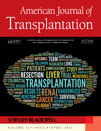The Need for Better Understanding of Transplant Glomerulitis
To the Editor:
We read the article by Batal et al., as well as the accompanying editorial by Gibson, with great interest (1,2). The authors have evaluated glomerulitis, using three different scoring systems in 112 biopsies with tubulointerstitial inflammation and concluded that the current Banff approach is superior to the other two methods studied and showed that biopsies with g3 are more likely to be associated with DSA (40%) and PTC C4d (50%) positivity, persistence of glomerulitis and worse graft survival. We have some concerns regarding the way that this study was designed and the interpretation of the data.
- 1
As pointed out in the accompanying editorial and shown in our recent study (3), glomerulitis is not necessarily accompanied by tubulointerstitial inflammation. Therefore, assessing its association with graft outcome and AMR will be biased by excluding the biopsies with i0/t0. On the other hand, the obligatory presence of at least borderline acute cell-mediated rejection adds an important confounding element in the analysis of the data.
- 2
The investigators have included biopsies from all periods post-transplant. Since antibody-mediated graft injury tends to cause acute histological changes and acute graft dysfunction in early post-transplant phase, and chronic, slow graft deterioration with transplant glomerulopathy and IF/TA in later stages, it is very likely that the impact and role of glomerulitis to be different at different time periods after transplantation.
- 3
The authors have handpicked the biopsies with g3 from a time period different from the rest of the biopsies, which can produce an important selection bias.
- 4
The authors include neutrophils as part of glomerulitis ‘since the number of neutrophils correlates with the diagnosis and outcome of AMR’. This practice could introduce a bias by indication in interpreting the findings. Furthermore, it is not clear how including neutrophils corresponds to the Banff definition of glomerulitis that is based on identification of mononuclear cells (4).
- 5
The association of different degrees of glomerulitis with graft survival was examined without adjustment for other variables, including DSA, PTC C4d, TG and ci. This multifactorial analysis is necessary to dissect the role of glomerulitis (g score) from the multitude of the other parameters affecting graft outcome. We have recently shown that in biopsies performed after the 1st year post-transplant, although the g score is predictive of chronic microvascular injury and worse prognosis, it is not independently associated with graft outcome. In contrast, the number of glomerular CD68-positive cells in the most inflamed glomerulus was the only independent predictor of graft survival.
This study is an important step in the right direction addressing the methodological and clinical significance of issues related to glomerular inflammation in transplant biopsies. Emerging data from several studies point to the paramount importance of microvascular inflammation/injury in general and glomerulitis in particular in determining graft outcome. Therefore, there is a real need to better define glomerulitis immunophenotypically, as well as in the context of cellular and antibody-mediated graft injury.
Disclosure
The authors of this manuscript have no conflicts of interest to disclose as described by the American Journal of Transplantation.




